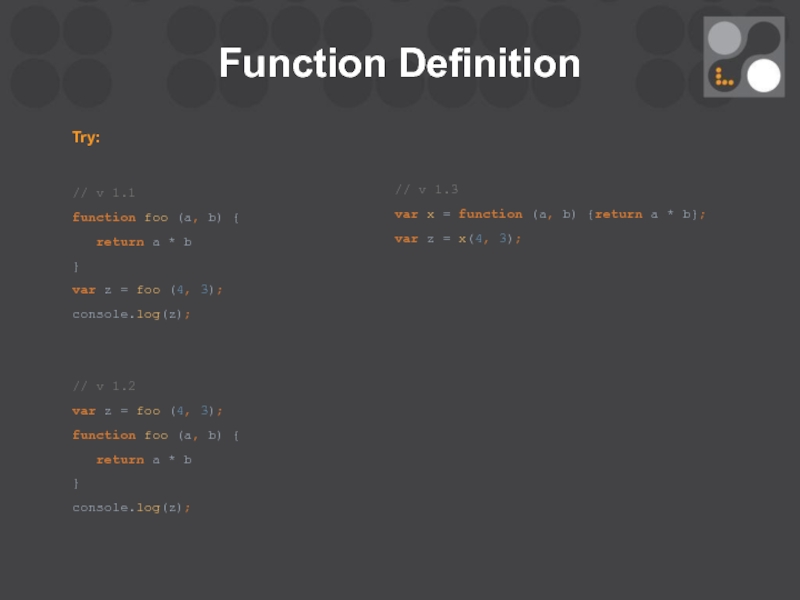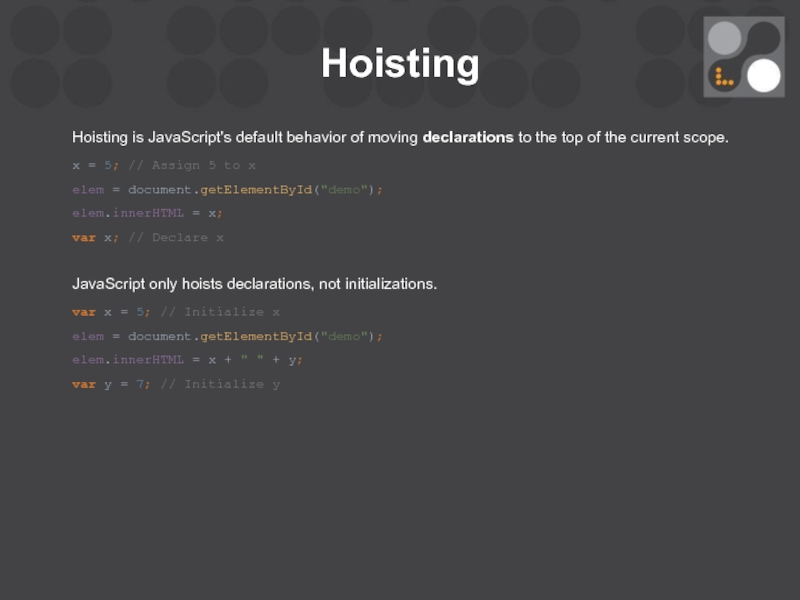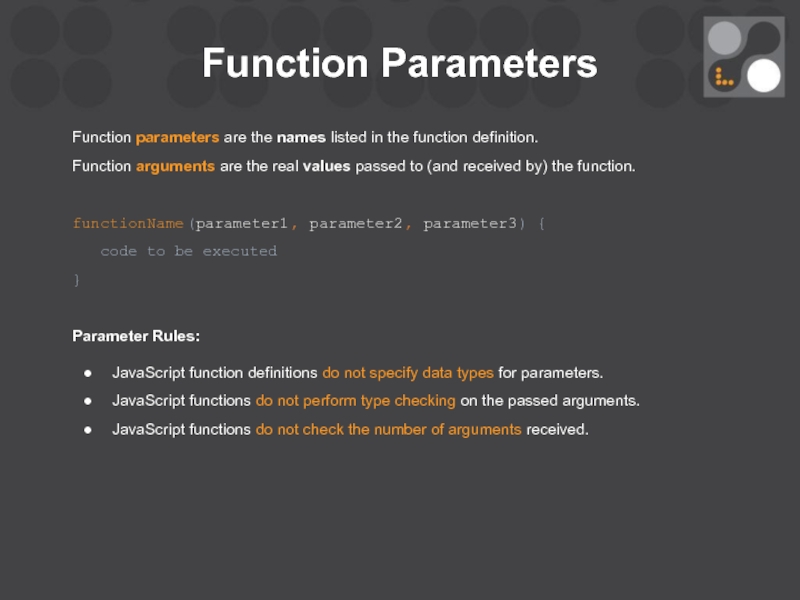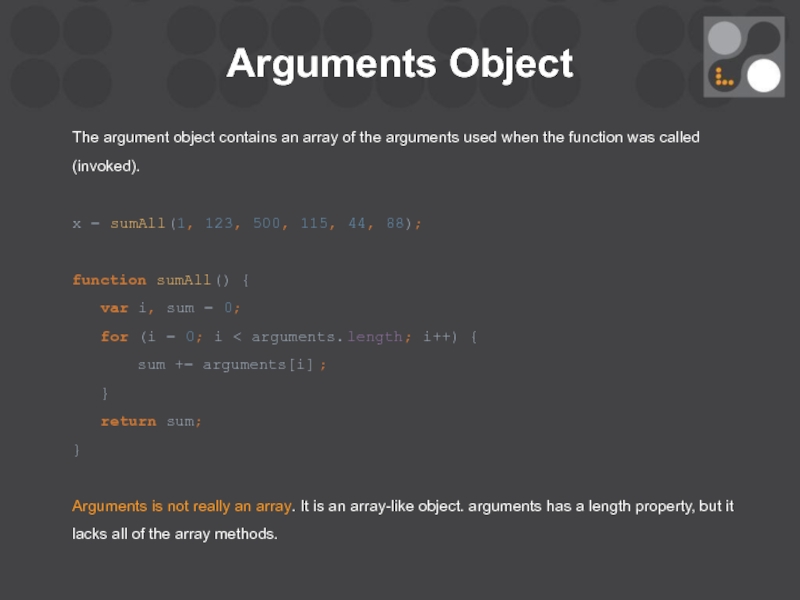- Главная
- Разное
- Дизайн
- Бизнес и предпринимательство
- Аналитика
- Образование
- Развлечения
- Красота и здоровье
- Финансы
- Государство
- Путешествия
- Спорт
- Недвижимость
- Армия
- Графика
- Культурология
- Еда и кулинария
- Лингвистика
- Английский язык
- Астрономия
- Алгебра
- Биология
- География
- Детские презентации
- Информатика
- История
- Литература
- Маркетинг
- Математика
- Медицина
- Менеджмент
- Музыка
- МХК
- Немецкий язык
- ОБЖ
- Обществознание
- Окружающий мир
- Педагогика
- Русский язык
- Технология
- Физика
- Философия
- Химия
- Шаблоны, картинки для презентаций
- Экология
- Экономика
- Юриспруденция
Introduction to JavaScript Functions (part 3) презентация
Содержание
- 1. Introduction to JavaScript Functions (part 3)
- 2. Functions
- 3. A JavaScript function is a block of
- 4. A JavaScript function is a block of
- 5. Functions
- 6. Invocation: When an event occurs (when
- 7. Invocation: When an event occurs (when
- 8. Function Purpose Reuse Information hiding Purpose Composition
- 9. Function Purpose
- 10. Function Definition JavaScript functions are defined
- 11. Function Definition JavaScript functions are defined
- 12. Function Definition JavaScript functions are defined
- 13. Function Definition The Function() Constructor:
- 14. Function Definition The Function() Constructor: Anti-pattern
- 15. Function Definition Try: // v
- 16. Function Definition Try: // v
- 17. Function Definition Try: // v
- 18. Function Definition Try: // v
- 19. Function Definition Try: // v
- 20. Hoisting Hoisting is JavaScript's default behavior
- 21. Hoisting Hoisting is JavaScript's default behavior
- 22. Hoisting Hoisting is JavaScript's default behavior
- 23. Hoisting
- 24. Self-Invoking Functions You have to add parentheses
- 25. Self-Invoking Functions You have to add parentheses
- 26. Function Parameters Function parameters are the names
- 27. Function Parameters Function parameters are the names
- 28. Function Parameters If a function is called
- 29. Function Parameters If a function is called
- 30. Arguments Object The argument object contains an
- 31. Arguments Object The argument object contains an
- 32. Function Invocation Invoking a function suspends the
- 33. Function Invocation Invoking a function suspends the
- 34. Function Invocation Invoking a function suspends the
- 35. Invoking a Function as a Method When
- 36. Invoking a Function as a Function The
- 37. Invoking a Function as a Function The
- 38. Invoking a Function as a Function !!!
- 39. Invoking a Function as a Function Fortunately,
- 40. Invoking a Function with a Function Constructor
- 41. Invoking a Function with a Function Constructor
- 42. Invoking a Function with a Function Method
- 43. Invoking a Function with a Function Method
- 44. Invoking a Function with a Function Method
- 45. Good night, folks!
Слайд 3A JavaScript function is a block of code designed to perform
A JavaScript function is executed when "something" invokes it (calls it).
Inside the function, the arguments are used as local variables.
functionName(parameter1, parameter2, parameter3) {
code to be executed
}
JavaScript Functions
Слайд 4A JavaScript function is a block of code designed to perform
A JavaScript function is executed when "something" invokes it (calls it).
Inside the function, the arguments are used as local variables.
functionName(parameter1, parameter2, parameter3) {
code to be executed
}
JavaScript Functions
function myFunction(p1, p2) {
return p1 * p2;
}
var x = myFunction(5, 10);
console.log(x);
Слайд 6Invocation:
When an event occurs (when a user clicks a button)
When it
Automatically (self invoked)
Functions
Слайд 7Invocation:
When an event occurs (when a user clicks a button)
When it
Automatically (self invoked)
Return:
When JavaScript reaches a return statement, the function will stop executing.
The return value is "returned" back to the "caller".
Functions
Слайд 10Function Definition
JavaScript functions are defined with the function keyword.
You can
Слайд 11Function Definition
JavaScript functions are defined with the function keyword.
You can
A function expression can be stored in a variable:
var x = function (a, b) {return a * b};
Слайд 12Function Definition
JavaScript functions are defined with the function keyword.
You can
A function expression can be stored in a variable:
var x = function (a, b) {return a * b};
After a function expression has been stored in a variable, the variable can be used as a function:
var z = x(4, 3);
The function above is actually an anonymous function (a function without a name).
Слайд 13Function Definition
The Function() Constructor:
var myFunction = new Function("a", "b", "return
// the same
var myFunction = function (a, b) {return a * b};
Слайд 15Function Definition
Try:
// v 1.1
function foo (a, b) {
return
}
var z = foo (4, 3);
console.log(z);
Слайд 16Function Definition
Try:
// v 1.1
function foo (a, b) {
return
}
var z = foo (4, 3);
console.log(z);
// v 1.2
var z = foo (4, 3);
function foo (a, b) {
return a * b;
}
console.log(z);
Слайд 17Function Definition
Try:
// v 1.1
function foo (a, b) {
return
}
var z = foo (4, 3);
console.log(z);
// v 1.2
var z = foo (4, 3);
function foo (a, b) {
return a * b
}
console.log(z);
// v 1.3
var x = function (a, b) {return a * b};
var z = x(4, 3);
Слайд 18Function Definition
Try:
// v 1.1
function foo (a, b) {
return
}
var z = foo (4, 3);
console.log(z);
// v 1.2
var z = foo (4, 3);
function foo (a, b) {
return a * b
}
console.log(z);
// v 1.3
var x = function (a, b) {return a * b};
var z = x(4, 3);
// v 1.4
var z = x(4, 3);
var x = function (a, b) {return a * b};
Слайд 19Function Definition
Try:
// v 1.1
function foo (a, b) {
return
}
var z = foo (4, 3);
console.log(z);
// v 1.2
var z = foo (4, 3);
function foo (a, b) {
return a * b
}
console.log(z);
// v 1.3
var x = function (a, b) {return a * b};
var z = x(4, 3);
// v 1.4
var z = x(4, 3);
var x = function (a, b) {return a * b};
WTF?
Слайд 20Hoisting
Hoisting is JavaScript's default behavior of moving declarations to the
x = 5; // Assign 5 to x
elem = document.getElementById("demo");
elem.innerHTML = x;
var x; // Declare x
Слайд 21Hoisting
Hoisting is JavaScript's default behavior of moving declarations to the
x = 5; // Assign 5 to x
elem = document.getElementById("demo");
elem.innerHTML = x;
var x; // Declare x
JavaScript only hoists declarations, not initializations.
var x = 5; // Initialize x
elem = document.getElementById("demo");
elem.innerHTML = x + " " + y;
var y = 7; // Initialize y
Слайд 22Hoisting
Hoisting is JavaScript's default behavior of moving declarations to the
x = 5; // Assign 5 to x
elem = document.getElementById("demo");
elem.innerHTML = x;
var x; // Declare x
JavaScript only hoists declarations, not initializations.
var x = 5; // Initialize x
elem = document.getElementById("demo");
elem.innerHTML = x + " " + y;
var y = 7; // Initialize y
To avoid bugs, always declare all variables at the beginning of every scope!!!
Слайд 24Self-Invoking Functions
You have to add parentheses around the function to indicate
(function () {
console.log("Hello!!"); // I will invoke myself
})();
Слайд 25Self-Invoking Functions
You have to add parentheses around the function to indicate
(function () {
console.log("Hello!!"); // I will invoke myself
})();
WHAT FOR:
precompute
create scope
Слайд 26Function Parameters
Function parameters are the names listed in the function definition.
Function
functionName(parameter1, parameter2, parameter3) {
code to be executed
}
Слайд 27Function Parameters
Function parameters are the names listed in the function definition.
Function
functionName(parameter1, parameter2, parameter3) {
code to be executed
}
Parameter Rules:
JavaScript function definitions do not specify data types for parameters.
JavaScript functions do not perform type checking on the passed arguments.
JavaScript functions do not check the number of arguments received.
Слайд 28Function Parameters
If a function is called with missing arguments (less than
Assign a default value to the parameter:
function myFunction(x, y) {
y = y || 0;
console.log(x, y);
}
Слайд 29Function Parameters
If a function is called with missing arguments (less than
Assign a default value to the parameter:
function myFunction(x, y) {
y = y || 0;
console.log(x, y)
}
If a function is called with too many arguments (more than declared), these arguments cannot be referred, because they don't have a name. They can only be reached in the arguments object.
Слайд 30Arguments Object
The argument object contains an array of the arguments used
x = sumAll(1, 123, 500, 115, 44, 88);
function sumAll() {
var i, sum = 0;
for (i = 0; i < arguments.length; i++) {
sum += arguments[i];
}
return sum;
}
Слайд 31Arguments Object
The argument object contains an array of the arguments used
x = sumAll(1, 123, 500, 115, 44, 88);
function sumAll() {
var i, sum = 0;
for (i = 0; i < arguments.length; i++) {
sum += arguments[i];
}
return sum;
}
Arguments is not really an array. It is an array-like object. arguments has a length property, but it lacks all of the array methods.
Слайд 32Function Invocation
Invoking a function suspends the execution of the current function,
Слайд 33Function Invocation
Invoking a function suspends the execution of the current function,
In JavaScript, the thing called this, is the object that "owns" the current code.
*Note that this is not a variable. It is a keyword.
Слайд 34Function Invocation
Invoking a function suspends the execution of the current function,
In JavaScript, the thing called this, is the object that "owns" the current code.
*Note that this is not a variable. It is a keyword.
When a function is called without an owner object, the value of this becomes the global object.
Слайд 35Invoking a Function as a Method
When a function is stored as
The binding of this to the object happens at invocation time. This very late binding makes functions that use this highly reusable.
var myObject = {
firstName:"Bilbo",
lastName: "Baggins",
fullName: function () {
return this.firstName + " " + this.lastName;
},
getContex: function () {
return this;
}
}
myObject.fullName();
myObject.getContex();
Слайд 36Invoking a Function as a Function
The function does not belong to
The function automatically becomes a window function.
function myFunction(a, b) {
return a * b;
}
myFunction(10, 2); // myFunction(10, 2) will return 20
window.myFunction(10, 2); // window.myFunction(10, 2) will also return 20
Слайд 37Invoking a Function as a Function
The function does not belong to
The function automatically becomes a window function.
function myFunction(a, b) {
return a * b;
}
myFunction(10, 2); // myFunction(10, 2) will return 20
window.myFunction(10, 2); // window.myFunction(10, 2) will also return 20
function myFunction() {
return this;
}
myFunction(); // Will return the window object
Слайд 38Invoking a Function as a Function
!!! A method cannot employ an
var add = function (a, b) {
return a + b;
};
var myObject = {
value: 10
}
myObject.double = function () {
var helper = function () {
this.value = add(this.value, this.value);
};
helper(); // Invoke helper as a function.
};
// Invoke double as a method.
myObject.double();
console.log(myObject.value);
Слайд 39Invoking a Function as a Function
Fortunately, there is an easy workaround.
var
return a + b;
};
var myObject = {
value: 10
}
myObject.double = function () {
var that = this;
var helper = function () {
that.value = add(that.value, that.value);
};
helper(); // Invoke helper as a function.
};
// Invoke double as a method.
myObject.double();
console.log(myObject.value);
Слайд 40Invoking a Function with a Function Constructor
If a function invocation is
It looks like you create a new function, but since JavaScript functions are objects you actually create a new object:
// This is a function constructor:
function myFunction(arg1, arg2) {
this.firstName = arg1;
this.lastName = arg2;
}
// This creates a new object
var x = new myFunction("Bilbo","Baggins");
x.firstName;
Слайд 41Invoking a Function with a Function Constructor
If a function invocation is
It looks like you create a new function, but since JavaScript functions are objects you actually create a new object:
// This is a function constructor:
function myFunction(arg1, arg2) {
this.firstName = arg1;
this.lastName = arg2;
}
// This creates a new object
var x = new myFunction("Bilbo","Baggins");
x.firstName;
The new prefix also changes the behavior of the return statement.
Слайд 42Invoking a Function with a Function Method
In JavaScript, functions are objects.
call() and apply() are predefined JavaScript function methods. Both methods can be used to invoke a function, and both methods must have the owner object as first parameter. The only difference is that call() takes the function arguments separately, and apply() takes the function arguments in an array.
var array = [3, 4];
var sum = add.apply(null, array);
Слайд 43Invoking a Function with a Function Method
// Create a constructor function
var Quo = function (string) {
this.status = string;
};
// Give all instances of Quo a public method called get_status.
Quo.prototype.get_status = function ( ) {
return this.status;
};
// Make an instance of Quo.
var myQuo = new Quo("confused");
console.log(myQuo.get_status()); // confused
Слайд 44Invoking a Function with a Function Method
// Create a constructor function
var Quo = function (string) {
this.status = string;
};
// Give all instances of Quo a public method called get_status.
Quo.prototype.get_status = function ( ) {
return this.status;
};
// Make an instance of Quo.
var myQuo = new Quo("confused");
console.log(myQuo.get_status()); // confused
// Make an object with a status member.
var statusObject = {
status: 'OK'
};
// statusObject does not inherit from Quo.prototype, but we can invoke the get_status method on statusObject even though statusObject does not have a get_status method.
var status = Quo.prototype.get_status.apply(statusObject);
// status is 'OK'


















































